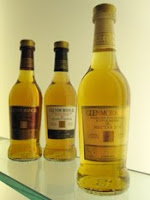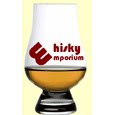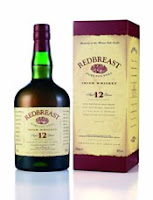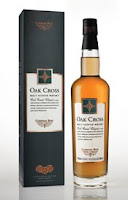 A marriage made in heaven?
A marriage made in heaven?The association between whisky and cigars has a long history and is one that remains strong. Many people enjoy a dram of whisky with a cigar as an evening pastime, as part of a celebration or just for enjoyment. We recently had the opportunity to learn more about cigars at a beginner’s class operated by
Hunters & Frankau, the UK’s leading independent importer for Cuban cigars.
Hunters & Frankau have been trading since 1790 and you can learn more about them and their range at
www.cigars.co.uk. As we knew nothing about cigars before the class, we decided to write this post to show some basics that were learnt and will help us understand more. We hope this helps if you find yourselves in a similar position to us! We will concentrate on the Cuban cigar industry, although tobacco is grown and many of the same practices are followed in other countries around the world. Here goes ... it's a long one!
 Why Cuba?
Why Cuba?Cuba is regarded by many as the spiritual home of cigar production and is renowned for producing some of the world’s finest cigars. It is home to some of the world’s best known cigar brands such as
Romeo y Julieta,
Montechristo and
Cohiba. Cuba is a Caribbean island that lies between the southern tip of Florida, USA and the island of Jamaica. Cuba’s climate and fertile soil gives it ideal conditions for growing tobacco plants and the island has a rich heritage connected with tobacco. When Christopher Columbus landed on Cuba in 1492, he was greeted by the natives and was offered
cohibas (the Spanish word for cigar) and tobacco plants as gifts. It is believed that the cohibas formed part of the island’s ceremonial festivals. Columbus cannot have realised the immense effect that his ‘discovery’ would have on the world!
 The tobacco plant
The tobacco plantTobacco plants have large flat leaves and in the cigar industry these leaves are graded. The plant is split in to three sections – the leaves at the base are called
volado, the leaves in the centre are
seco and the leaves at the top are
ligero. Each type of leaf has its own properties and is used in different parts of the cigar and cigar making process. It is believed that all of the native tobacco plants on Cuba are directly descended from the plants that were around when Columbus arrived over 500 years ago. The Cuban Black Tobacco (Latin name
tabaco negro cubano) was a wild plant before it was first farmed and cultivated in the 16th century. It is grown in defined regions (similar to the ‘denomination of origin’ system in wine – ie:
Champagne,
Chianti,
Rioja etc), and each has an exceptional soil and micro-climate to produce high quality tobacco. These are called the
Vegas Finas de Primera and there are four –
*Vuelta Abajo (on the far western tip of Cuba and regarded as producing the best tobacco in the world)
*Semi Vuelta (still on the western peninsula but further inland)
*Partido (further east and the closest region to Havana, Cuba’s capital)
*Vuelta Arriba (this is split in to two areas – one in Central Cuba called
Remedios, which is the oldest growing area in Cuba and one on the eastern peninsula called
Oriente).
Different types of cigarsThere are two methods of making a cigar – by machine or by hand. The machine made cigars are named
mecanizado in Cuba and the hand made cigars or
totalmente a mano, fall in to two categories –
tripa larga and
tripa corta. The
tripa larga are known as long filler cigars in English and are made from complete tobacco leaves.
Tripa corta cigars are also known as short fillers and are made using chopped tobacco leaves or
picadura in Spanish.
The anatomy of a cigarA cigar is made up of three parts – the filler, the binder and the wrapper. Each part uses leaves from the different parts of the tobacco plant to fulfill different functions. The filler forms the main body of the cigar and is made using a combination of the three classification of leaf from the tobacco plant – the
volado,
seco and
ligero. These give the cigar its main flavour profile. The
volado leaves from the base of the plant are mild in flavour, the
seco leaves from the middle are more flavoursome and the
ligero leaves from the top have the most intense flavour. This is due to the
ligero undergoing more photosynthesis and being younger and fresher than the lower leaves on the plant. It results in the
ligero having more sweetness and a darker colour than the
volado and
seco when they are dried.
The blend of the three filler leaves is then secured with a binder leaf. This holds them together and these binder leaves are taken from the top part of the plant, but undergo a slightly different treatment to the filler
ligero leaves. The final part is the wrapper leaf, which contributes little flavour but is secured tightly in order to present the cigar in the best way. These wrapper leaves are grown in a different way and produce the most expensive tobacco. They are grown for a majority of the time under a muslin cover and this filters the sunlight and traps heat, allowing the leaves to grow larger and finer. By contrast, the leaves for the filler and binder leaves are grown in the open and under direct sunlight. In summary, five leaves are used to produce a cigar – three fillers for flavour, one binder for structure and one wrapper for presentation.
 How cigars are made by hand?
How cigars are made by hand?Once fully grown, the tobacco leaves are harvested and graded depending on their role in the final cigar. The leaves are harvested in stages, with the base leaves being taken first and the others being taken over the following 30 days, finishing with the youngest top leaves of the plant. The leaves are taken to a
casas de tabaco or curing barn and are hung in pairs on large racks. This removes moisture, with the leaves turn golden brown over time. The wrapper leaves take around 25 days for this to occur. The binder and filler leaves are given about twice as long.
The leaves are then placed in piles and undergo natural fermentation (similar to a garden compost heap), removing many impurities. The
ligero filler leaves and wrapper leaves take around 30 days for this to happen, with the
seco and
volado filler leaves and the binding leaves taking 25 days. Following this, the leaves are sorted by size, texture and colour before the filler and binder leaves undergo a second fermentation stage. The times vary with the
volado and binders having a further 45 days, the
seco around 60 and the
ligero having up to 90.
They are then gathered in to bundles and wrapped in hessian to be aged. These bales are called
pacas. The
volado are aged for a minimum of nine months,
seco for 12-18 months and
ligero for two years. The wrapper leaves do not undergo a second fermentation but are packed in similar bales after the sorting process. These bales are called
tercios and are made from the bark of palm trees. wrapper leaves are aged for a minimum of six months.
Before the cigar is made, the leaves must be moistened, checked for classification and stripped of their stems. The leaves are then passed to a
ligador or master blender, who constructs the complex blend for the brand of cigar that is to be made. The exact ratios of each type of leaf that goes in to the blend is a closely guarded secret that only the
ligador knows. The blend of leaves is then passed to the
torcedores, the highly skilled craftsmen and women who hand roll the cigars (
torcedoras for the ladies!).
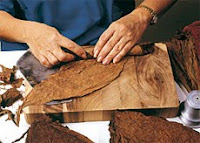
Firstly, in the production of
tripa larga (long filler) cigars the binder leaves are laid out and the whole filler leaves are folded and aligned to allow the passage of smoke to travel along the length of the finished cigar. The most flavoursome
ligero leaves are placed in the centre and are then wrapped in
seco and then
volado leaves on the outside. It is also constructed so that the intensity of flavour will increase as the cigar is smoked. These filler leaves are then tightly rolled using the binder leaves to ensure that they are compressed evenly along the length of the cigar.
The dimensions follow strict guidelines for length, girth and weight. After 30 minutes in a wooden mould, the
tocedor then applies the delicate wrapper leaf by stretching and straightening the leaf to ensure a perfect tension and appearance. Finally, a small piece of tobacco leaf is used to cap the head (the end that goes in your mouth) of the cigar, is cut off before smoking, and the other end is guillotined to size. A
torcedor can produce 100-150 cigars a day. The completed cigars are then sent to be labeled, tested for quality, sorted and boxed.
The production of
tripa corta (short filler) cigars is similar but they use the trimmings/parts of leaves left from the leaves used in
tripa larga production, rather than the whole leaves. The bunch of trimmings is rolled tightly using a flexible mat and then the binder and wrapper leaves are applied in the regular way. In machine made cigars the three leaves are in much smaller pieces and are specifically blended. They are then tightly packed together and bound with a binder leaf and finished with a wrapper leaf by the machine.
 Different sizes
Different sizesCigars come in all shapes and sizes and there are over 70 just from Cuba alone. The length ranges from four inches (100mm) to 9 inches (230mm), although most are between 5 and 7 inches. The other important measurement is the diameter or girth. This is measured by a system called the 'ring gauge' and this is measured in fractions of an inch (64ths of an inch to be exact!). The common range is between 23 (ie - 23/64ths of an inch or 9.1mm) and 52 (52/64ths of an inch or 20.6mm), although cigars are produced that are smaller and larger than this.
The length, diameter and shape of a cigar will effect the final taste and experience - a big, fat, long cigar will burn slower, be richer and softer in flavour and give cooler smoke to the palate whereas a thinner, shorter cigar will burn more quickly, give sharper flavours and hotter smoke on the palate. Each size has its own name or
vitola, although it can get very confusing as a) the name given in the factory is different to the name that goes on sale and b) each factory has a different name for the same size of cigar.
Cigar and whisky matchingAs stated at the beginning, the marriage of cigars and whisky is historical. Rumour has it that it all began during the Napoleonic wars in the early 1800s, when the British and Spanish were fighting to defeat the French - the British supplying the whisky from Scotland and the Spanish bringing their love of cigars from Cuba, which was part of their expanding empire. The trend has continued as the British moved from traditional pipe tobacco to cigars and then took the practice of combining whisky and cigars around the globe with the spread of the British Empire.
The most important thing to consider when matching whisky with a cigar (or indeed anything else - cheese, desserts etc) is to not have one that overpowers the other. A balance is needed so that one compliments the flavours and aromas of the other and vice versa. For example - a robust cigar matched with a light, fresh whisky would completely cover the subtle, vibrant notes in the whisky. Likewise, a very peaty whisky matched with a milder, creamier cigar would do the same. Generally, most cigars would seem to go well with a sherry cask matured whisky (these have extra sweetness and fruitiness that can deal with the strength of the tobacco) or a lightly peated/smoky whisky (these exhibit a similar strength of smoky flavour to the cigar). A more robust strong cigar would need a heavier, smokier whisky to combat its higher levels of aromas and flavour. Considering these factors when buying whisky and cigars will help, as will the advice of the people in the stores where you choose to buy them.
Check out the expertsWe are new to the world of cigars and have tried to lay down some of the basics in this article. As we have found, once you dip your 'beginners' toe in to the water then you discover a lot more beneath the surface. The cigar industry can seem quite daunting from the outside but this is no different from the world of whisky, where a little basic knowledge can get you a long way. As in the whisky world, there are many people out there writing about and reviewing cigars. We have discovered numerous excellent blogs and sites, so check out some of these for much more information and expertise than we can offer -
Cigar Jack,
World of Cigars,
Cigar Chick,
CigarFox,
Tobacconist University,
Cigars4Women and our personal favourites
Cigarblog and
Cigar Inspector. In addition, our friends at the excellent WHISKYhost blog offer regular
whisky and cigar matchings, including good combinations and tasting notes.
* Please note that all images used in this article have been taken from Google images.
 Two casks, one whisky
Two casks, one whisky




